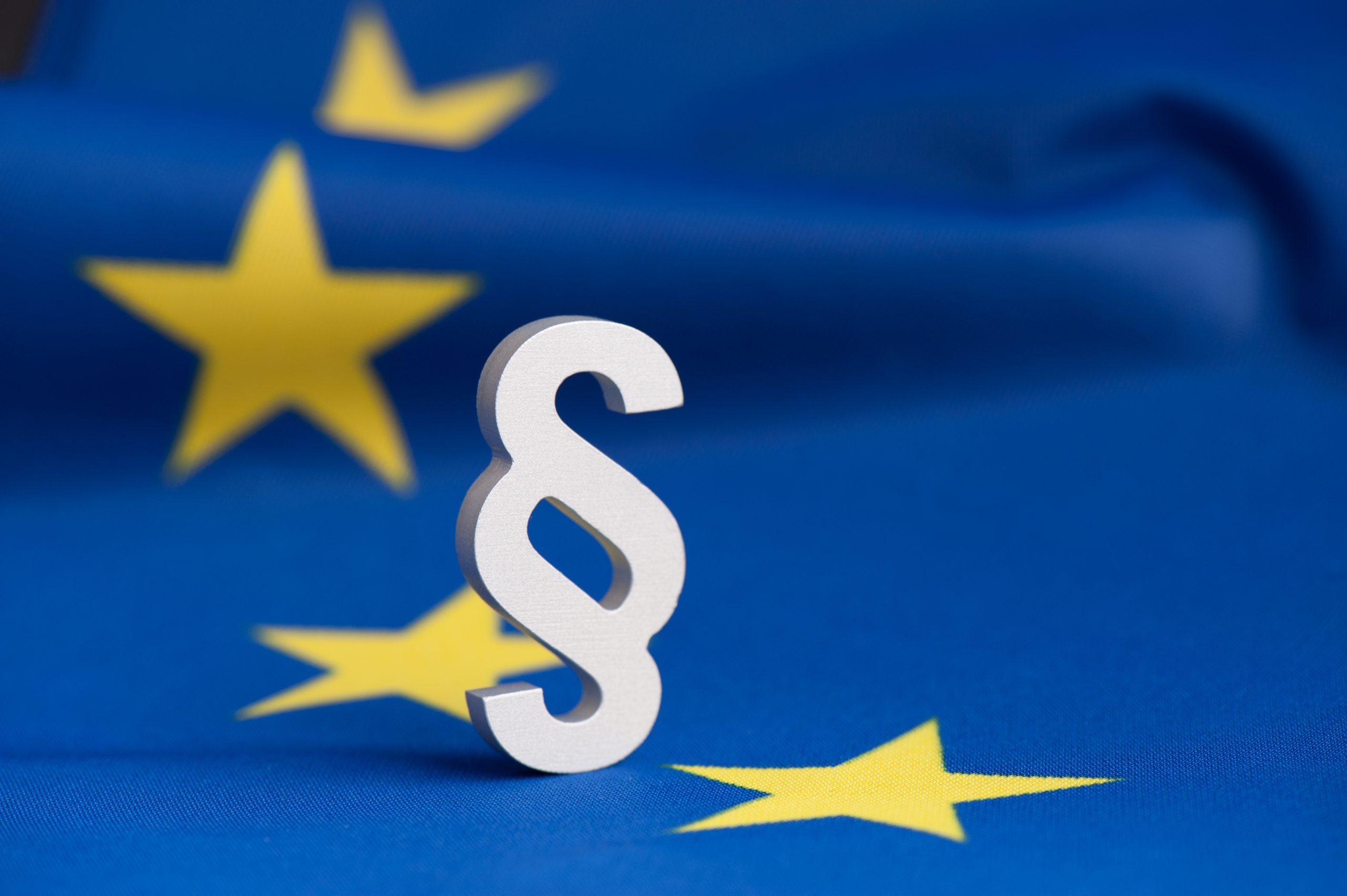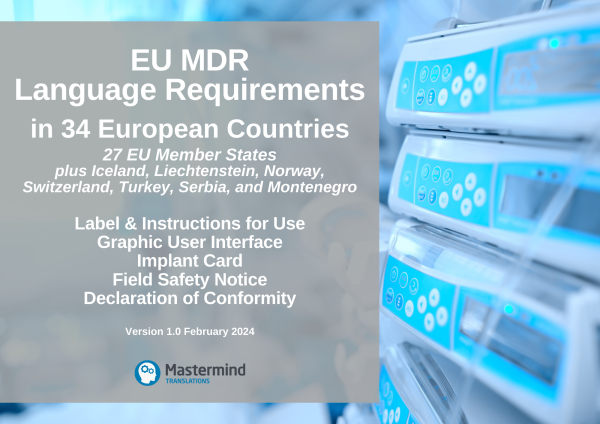Before placing your medical device on the EU market, as the manufacturer you must first demonstrate that your product complies with the applicable EU legislation. The EU declaration of conformity is an essential document in this regulatory process. Depending on the EU Member State where your medical device will be made available, the EU declaration of conformity may also need translating into the country’s national language(s). In this article, we will discuss the EU MDR/IVDR language requirement for the declaration of conformity. You will also learn which language versions of it individual EU Member States accept.
Read this article in German or French.
Before we examine the language requirement for the declaration of conformity under the Medical Device Regulation (MDR) 2017/745/EU and the In Vitro Diagnostic Medical Device Regulation (IVDR) 2017/746/EU in more detail, it is worth briefly explaining what the EU declaration of conformity is, and what purpose it serves.
What is the EU declaration of conformity?
The EU declaration of conformity (often referred to as the DoC) is a mandatory document that you as a manufacturer need to draw up and sign before placing your device on the EU market. By doing so, you declare that your medical device or in vitro diagnostic medical device conforms to the relevant requirements of the EU MDR or the EU IVDR, as well as to all other requirements set out in other applicable EU legislation.
In order to prove compliance with these requirements, manufacturers must first follow one of the conformity assessment procedures appropriate for the class of their medical device. Once it has been established that the device is in compliance, the manufacturer can declare this in the form of the EU declaration of conformity. By means of this self-issued declaration, the manufacturer assumes sole responsibility for compliance. On that basis, CE marking can be affixed to the device.
The EU declaration of conformity allows national competent authorities to identify who is responsible for the device, and the conformity assessments claimed by that person to have been undertaken.
Article 19(1) of the EU MDR and Article 17(1) of the EU IVDR lay down provisions for the EU declaration of conformity, and Annex IV specifies what information it should contain.
MDR, Article 19(1)
IVDR, Article 17(1)
The EU declaration of conformity shall state that the requirements specified in this Regulation have been fulfilled in relation to the device that is covered. The manufacturer shall continuously update the EU declaration of conformity. The EU declaration of conformity shall, as a minimum, contain the information set out in Annex IV […].
What is the EU MDR/IVDR language requirement for the declaration of conformity?
Similarly to the language requirements for the information accompanying the device, i.e. the label and IFU, the EU MDR and EU IVDR require that manufacturers have the EU declaration of conformity translated in an official EU language(s) of the national market in which the device is placed.
MDR, Article 19(1)
IVDR, Article 17(1)
[…]
The EU declaration of conformity […] shall be translated into an official Union language or languages required by the Member State(s) in which the device is made available.
Likewise, discretion is given to individual EU Member States to establish at the national level which language(s) they will accept under this EU MDR/IVDR language requirement for the declaration of conformity.
Which languages do individual EU Member States require under the EU MDR/IVDR language requirement for the declaration of conformity?
EU regulations are binding and directly applicable in all EU Member States without the need for any domestic implementing legislation. However, almost all EU Member States have by now issued or updated supplementary national legislation (or published official guidelines) to make provisions for matters, such as the language requirements, expected to be regulated at the national level.
Unlike the label and IFU, the EU declaration of conformity is a regulatory document and does not contain any safety or performance information for the user. For this reason, most EU Member States offer a level of flexibility in response to the EU MDR/IVDR language requirement for the declaration of conformity.
A majority of EU Member States, such as Belgium, accept a national language version(s) of the EU declaration of conformity or an English version. Some EU Member States, such as Austria, expect the EU declaration of conformity to be made available in the national language(s) only at the request of the national competent authority or the user of the device. A small number of EU Member States with stricter internal language rules, such as Latvia, require a translation in the national language to accompany the original document. Moreover, a couple of countries, i.e. Luxembourg and Poland, extrapolate the MDR/IVDR language requirements for the label and IFU to the EU declaration of conformity, and make a distinction for the language requirement for the declaration of conformity, depending on whether the device is intended for a layperson or a professional user.
The languages accepted for the declaration of conformity in the 27 EU Member States, Iceland, Liechtenstein, Norway, and Switzerland in line with the EU MDR/IVDR language requirement are listed below. Please note, however, that in some of these countries additional conditions or restrictions apply. These are marked with an asterisk (*). For more details, please refer to the EU MDR Language Requirements Table 2024 which has been updated to include the information published in January 2024 by the European Commission.
| Country | Language(s) Accepted for the EU Declaration of Conformity |
| Austria | German or another EU language* |
| Belgium | French or Dutch or German or English |
| Bulgaria | Bulgarian |
| Croatia | Croatian or English |
| Cyprus | Greek or English |
| Czech Republic | Czech or Slovak or English |
| Denmark | Danish or another EU language* |
| Estonia | Estonian or English |
| Finland | Finnish or Swedish or English |
| France | French |
| Germany | German or English |
| Greece | Greek or English |
| Hungary | Hungarian or English |
| Iceland** | Icelandic or English |
| Ireland | English or English and Irish |
| Italy | Italian or another EU language* |
| Latvia | Latvian and English* |
| Liechtenstein** | German or English |
| Lithuania | Lithuanian |
| Luxembourg | English and German or English and French or English* |
| Malta | Maltese or English |
| Netherlands | Dutch or English |
| Norway** | Norwegian or English |
| Poland | Polish or English* |
| Portugal | Portuguese or English |
| Romania | Romanian or English |
| Slovakia | Slovak or English* |
| Slovenia | Slovene or English* |
| Spain | Spanish or another EU language* |
| Sweden | Swedish or English |
| Switzerland*** | German or French or Italian or English |
| Turkey**** | Turkish |
Table updated: June 2023
* Special conditions or restrictions apply. Please refer to the EU MDR Language Requirements Table 2024 for more details.
** Member of the EEA
*** Not Member of the EU or the EEA (third country)
**** Customs Union with the EU
As a final note, it is worth adding that manufacturers are expected to keep an up-to-date version of the EU declaration of conformity available for the competent authorities for a period of at least 10 years after the last device covered by it has been placed on the market. That period is extended for 15 years for implantable devices. For this reason, it is essential to have a system in place to manage the various language versions too.
Where can we find more detailed information?
You can find more detailed information about the languages accepted in the 27 EU Member States, the three EEA EFTA Member States, Switzerland, Turkey, and the EU candidate countries of Serbia and Montenegro under the EU MDR language requirement for the declaration of conformity in our EU MDR Language Requirements Table 2024. In addition, this regularly updated resource has dedicated sections for the MDR language requirements for the label and instructions for use (IFU), graphical user interface (GUI), implant card, and field safety notice (FSN). It includes, where applicable, extracts from the national legislations and official guidelines from competent authorities translated into English, as well as links to reference sources.
Please note that the information provided in this article is for guidance only and does not constitute professional regulatory advice. In the case of specific questions related to regulatory compliance, we recommend seeking assistance from a competent QA/RA specialist.







